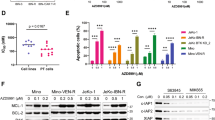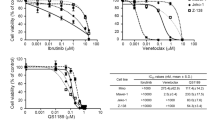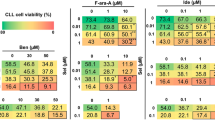Abstract
Primary effusion lymphomas (PELs) are a rare type of non-Hodgkin's lymphoma that are resistant to cytotoxic chemotherapy. PELs manifest constitutive activation of nuclear factor kappa B (NF-κB), and inhibition of NF-κB induces apoptosis of PELs and sensitizes to tumor necrosis factor-related apoptosis-inducing ligand (TRAIL)-induced death. Bortezomib (PS-341), a peptidyl boronic acid inhibitor of the proteasome, is a potent agent against a wide range of hematologic malignancies and has been shown to inhibit NF-κB. Thus, we examined the cytotoxic effects of bortezomib alone and in combination with various drugs. Bortezomib potently inhibited NF-κB in PEL cells in a dose-dependent manner. In addition, bortezomib inhibited growth and induced apoptosis of PEL cell lines (IC50 values of 3.4–5.0 nM). Results of drug interactions between bortezomib and chemotherapy (doxorubicin and Taxol) were schedule-dependent: synergistic interactions were generally observed when PEL cells were pretreated with bortezomib prior to chemotherapy, whereas additive or even antagonistic interactions occurred with chemotherapy pretreatment or simultaneous treatment with bortezomib and chemotherapy. Most schedules of bortezomib and dexamethasone were synergistic, although pretreatment with dexamethasone resulted in additive interactions. Effects of combinations of bortezomib and TRAIL were generally additive. Thus, bortezomib represents a promising potential therapy for the treatment of PEL.
This is a preview of subscription content, access via your institution
Access options
Subscribe to this journal
Receive 12 print issues and online access
$259.00 per year
only $21.58 per issue
Buy this article
- Purchase on Springer Link
- Instant access to full article PDF
Prices may be subject to local taxes which are calculated during checkout




Similar content being viewed by others
References
Komanduri KV, Luce JA, McGrath MS, Herndier BG, Ng VL . The natural history and molecular heterogeneity of HIV-associated primary malignant lymphomatous effusions. J Acquir Immune Defic Syndr Hum Retrovirol 1996; 13: 215–226.
Keller SA, Schattner EJ, Cesarman E . Inhibition of NF-kappaB induces apoptosis of KSHV-infected primary effusion lymphoma cells. Blood 2000; 96: 2537–2542.
Ghosh SK, Wood C, Boise LH, Mian AM, Deyev VV, Feuer G et al. Potentiation of TRAIL-induced apoptosis in primary effusion lymphoma through azidothymidine-mediated inhibition of NF-kappa B. Blood 2003; 101: 2321–2327.
Adams J, Palombella VJ, Sausville EA, Johnson J, Destree A, Lazarus DD et al. Proteasome inhibitors: a novel class of potent and effective antitumor agents. Cancer Res 1999; 59: 2615–2622.
Hideshima T, Richardson P, Chauhan D, Palombella VJ, Elliott PJ, Adams J et al. The proteasome inhibitor PS-341 inhibits growth, induces apoptosis, and overcomes drug resistance in human multiple myeloma cells. Cancer Res 2001; 61: 3071–3076.
Richardson PG, Barlogie B, Berenson J, Singhal S, Jagannath S, Irwin D et al. A phase 2 study of bortezomib in relapsed, refractory myeloma. N Engl J Med 2003; 348: 2609–2617.
Adams J . Development of the proteasome inhibitor PS-341. Oncologist 2002; 7: 9–16.
Pajonk F, McBride WH . The proteasome in cancer biology and treatment. Radiat Res 2001; 156: 447–459.
Palombella VJ, Rando OJ, Goldberg AL, Maniatis T . The ubiquitin–proteasome pathway is required for processing the NF-kappa B1 precursor protein and the activation of NF-kappa B. Cell 1994; 78: 773–785.
An J, Sun YP, Fisher M, Rettig MB . Maximal apoptosis of renal cell carcinoma by the proteasome inhibitor, bortezomib (VELCADETM, formerly known as PS-341), is NF-κB-dependent. Mol Cancer Ther 2004; 3: 727–736.
Chou TC, Talalay P . Quantitative analysis of dose–effect relationships: the combined effects of multiple drugs or enzyme inhibitors. Adv Enzyme Regul 1984; 22: 27–55.
Mitchell BS . The proteasome – an emerging therapeutic target in cancer. N Engl J Med 2003; 348: 2597–2598.
Bargou RC, Emmerich F, Krappmann D, Bommert K, Mapara MY, Arnold W et al. Constitutive nuclear factor-kappaB-RelA activation is required for proliferation and survival of Hodgkin's disease tumor cells. J Clin Invest 1997; 100: 2961–2969.
Davis RE, Brown KD, Siebenlist U, Staudt LM . Constitutive nuclear factor kappaB activity is required for survival of activated B cell-like diffuse large B cell lymphoma cells. J Exp Med 2001; 194: 1861–1874.
Cusack Jr JC, Liu R, Houston M, Abendroth K, Elliott PJ, Adams J et al. Enhanced chemosensitivity to CPT-11 with proteasome inhibitor PS-341: implications for systemic nuclear factor-kappaB inhibition. Cancer Res 2001; 61: 3535–3540.
An J, Sun YP, Adams J, Fisher M, Belldegrun A, Rettig MB . Drug interactions between the proteasome inhibitor bortezomib and cytotoxic chemotherapy, tumor necrosis factor (TNF) alpha, and TNF-related apoptosis-inducing ligand in prostate cancer. Clin Cancer Res 2003; 9: 4537–4545.
Lee RK, Cai JP, Deyev V, Gill PS, Cabral L, Wood C et al. Azidothymidine and interferon-alpha induce apoptosis in herpesvirus-associated lymphomas. Cancer Res 1999; 59: 5514–5520.
Toomey NL, Deyev VV, Wood C, Boise LH, Scott D, Liu LH et al. Induction of a TRAIL-mediated suicide program by interferon alpha in primary effusion lymphoma. Oncogene 2001; 20: 7029–7040.
Oya M, Ohtsubo M, Takayanagi A, Tachibana M, Shimizu N, Murai M . Constitutive activation of nuclear factor-kappaB prevents TRAIL-induced apoptosis in renal cancer cells. Oncogene 2001; 20: 3888–3896.
Ravi R, Bedi GC, Engstrom LW, Zeng Q, Mookerjee B, Gelinas C et al. Regulation of death receptor expression and TRAIL/Apo2L-induced apoptosis by NF-kappaB. Nat Cell Biol 2001; 3: 409–416.
Ashkenazi A, Pai RC, Fong S, Leung S, Lawrence DA, Marsters SA et al. Safety and antitumor activity of recombinant soluble Apo2 ligand. J Clin Invest 1999; 104: 155–162.
Lawrence D, Shahrokh Z, Marsters S, Achilles K, Shih D, Mounho B et al. Differential hepatocyte toxicity of recombinant Apo2L/TRAIL versions. Nat Med 2001; 7: 383–385.
Munshi A, Pappas G, Honda T, McDonnell TJ, Younes A, Li Y et al. TRAIL (APO-2L) induces apoptosis in human prostate cancer cells that is inhibitable by Bcl-2. Oncogene 2001; 20: 3757–3765.
Zisman A, Ng CP, Pantuck AJ, Bonavida B, Belldegrun AS . Actinomycin D and gemcitabine synergistically sensitize androgen-independent prostate cancer cells to Apo2L/TRAIL-mediated apoptosis. J Immunother 2001; 24: 459–471.
Ogiso Y, Tomida A, Lei S, Omura S, Tsuruo T . Proteasome inhibition circumvents solid tumor resistance to topoisomerase II-directed drugs. Cancer Res 2000; 60: 2429–2434.
Dong QG, Sclabas GM, Fujioka S, Schmidt C, Peng B, Wu T et al. The function of multiple IkappaB: NF-kappaB complexes in the resistance of cancer cells to Taxol-induced apoptosis. Oncogene 2002; 21: 6510–6519.
Sayers TJ, Brooks AD, Koh CY, Ma W, Seki N, Raziuddin A et al. The proteasome inhibitor PS-341 sensitizes neoplastic cells to TRAIL-mediated apoptosis by reducing levels of c-FLIP. Blood 2003; 102: 303–310.
Acknowledgements
Supported by grants from the National Institutes of Health (5R01CA80004) and the American Cancer Society (RPG-00-305-01-MBC) to MBR. In addition to supplying bortezomib, Millennium Pharmaceuticals, Incorporated, also provided financial support for this study.
Author information
Authors and Affiliations
Corresponding author
Additional information
Supplementary Information
Supplementary Information accompanies the paper on Leukemia website (http://www.nature.com/leu).
Rights and permissions
About this article
Cite this article
An, J., Sun, Y., Fisher, M. et al. Antitumor effects of bortezomib (PS-341) on primary effusion lymphomas. Leukemia 18, 1699–1704 (2004). https://doi.org/10.1038/sj.leu.2403460
Received:
Accepted:
Published:
Issue Date:
DOI: https://doi.org/10.1038/sj.leu.2403460
Keywords
This article is cited by
-
Betulinic acid chemosensitizes breast cancer by triggering ER stress-mediated apoptosis by directly targeting GRP78
Cell Death & Disease (2018)
-
Primary effusion lymphoma in an elderly patient effectively treated by lenalidomide: case report and review of literature
Blood Cancer Journal (2014)
-
YGLF motif in the Kaposi sarcoma herpes virus G-protein-coupled receptor adjusts NF-κB activation and paracrine actions
Oncogene (2014)
-
Perturbation of proteasome function by bortezomib leading to ER stress-induced apoptotic cell death in cholangiocarcinoma
Journal of Cancer Research and Clinical Oncology (2013)



